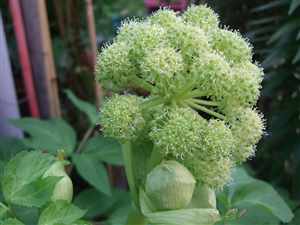Angelica (Angelica archangelica), Goutweed, Masterwort, Wild Parsnip
Main Facts about Angelica

Using Angelica
Angelica archangelica is the only one officially employed in medicine. All parts of the plant have medicinal properties, and have long been used in the treatment of respiratory diseases, as well as an aid to digestion. Angelica helps relieve indigestion, gas, flatulence, inflammation of the intestines, colic, heartburn. Try a cup of Angelica tea after a meal. It also help loosen congestion in the lungs by breaking apart mucus and making it easier to cough up and clear the lungs for bronchitis patients. The root has experctorant and diaphoretic properties. A root or leaves decoction was used to relieve insomnia and to induce period. Dried root powder is also used as antibacterial and anti-fungal for athlete’s foot.Angelica is a remedy for: Cold and flu
Caution!
Do not take if pregnant or diabetic. All members of this genus contain furocoumarins, which increase skin sensitivity to sunlight and may cause dermatitis. It thins blood, so don’t take it if you are on anticoagulants.Cooking with Angelica
Use seeds, stems, young leaves and shoots. Leaves used in salads or tea. Stems can be eaten raw. The roots are best in the autumn of the first year; the stems and leaves are at their peak in the spring of the second year; and the seeds are ready for use when mature. It is best known for its candied stems, used as a cake decoration. The stems and seeds are used in confectionery and flavouring and the preparation of liqueurs. (e.g. Chartreuse, Bénédictine, Vermouth and Dubonnet). Angelica seeds and angelica roots are sometimes used in making absinthe. For health problem boil or steep a teaspoon of the root or seeds in a cup of water.How to grow Angelica
Angelica loves woodland conditions, with plenty of moist shade, preferably near rivers or deposits of water. In their first year, plants produce leafy bushes, and then die down and disappear completely from sight in winter, in their second year they reach full size. Since Angelica seeds have both a low germination rate and the seed is comparatively short lived, it is recommended to plant some of the seeds as early as possible in late winter to spring. Plant in trays or pots containing a good quality seed compost. Just cover the seeds as they need light to germinate. The seedlings should be transplanted when they have their first set of true leaves and are still small.Angelica Toxic Look-alikes
Poison Hemlock (Cicuta maculata) and Giant Hogweed (Heracleum mantegazzianum)| Amaranth |
Anise
|